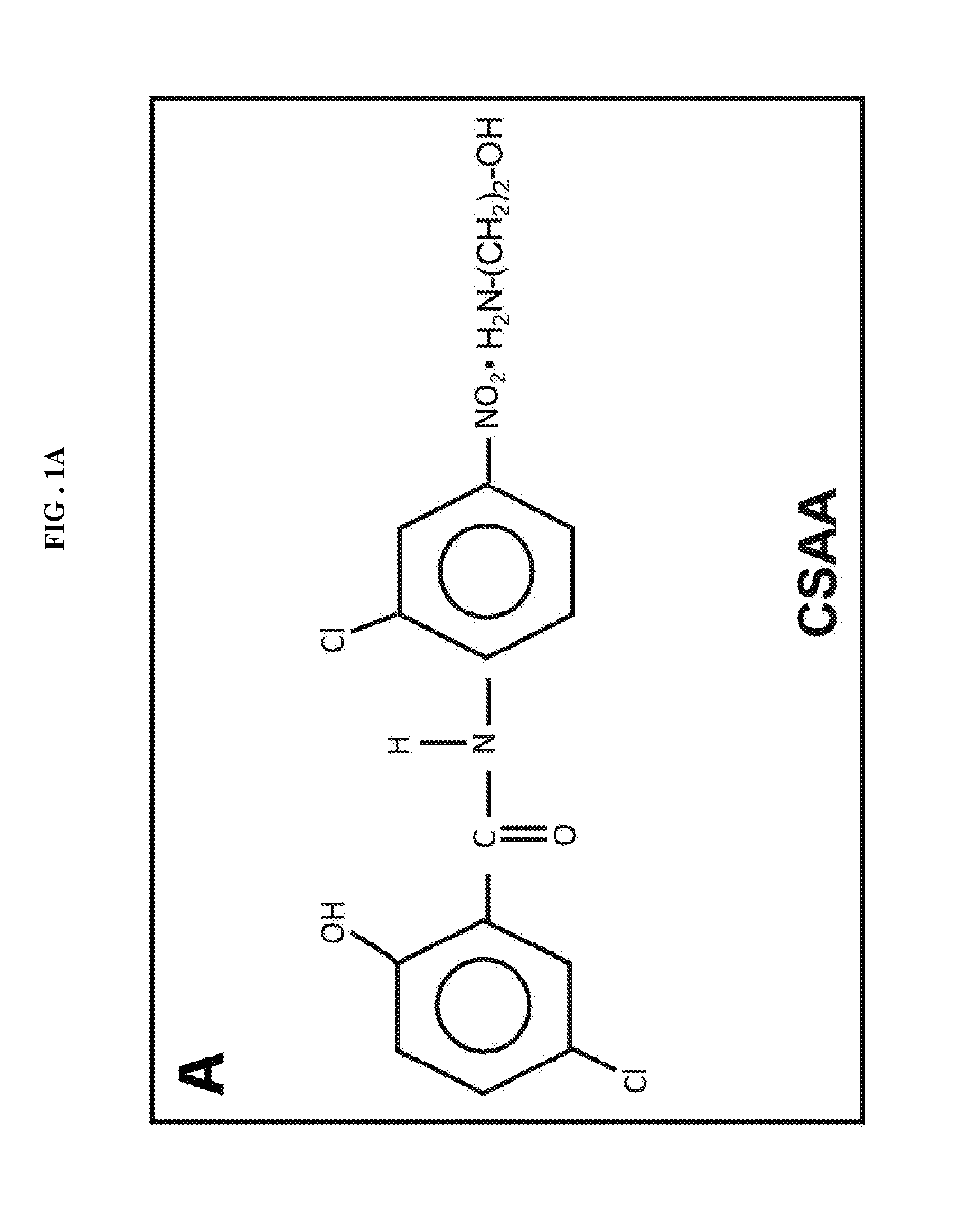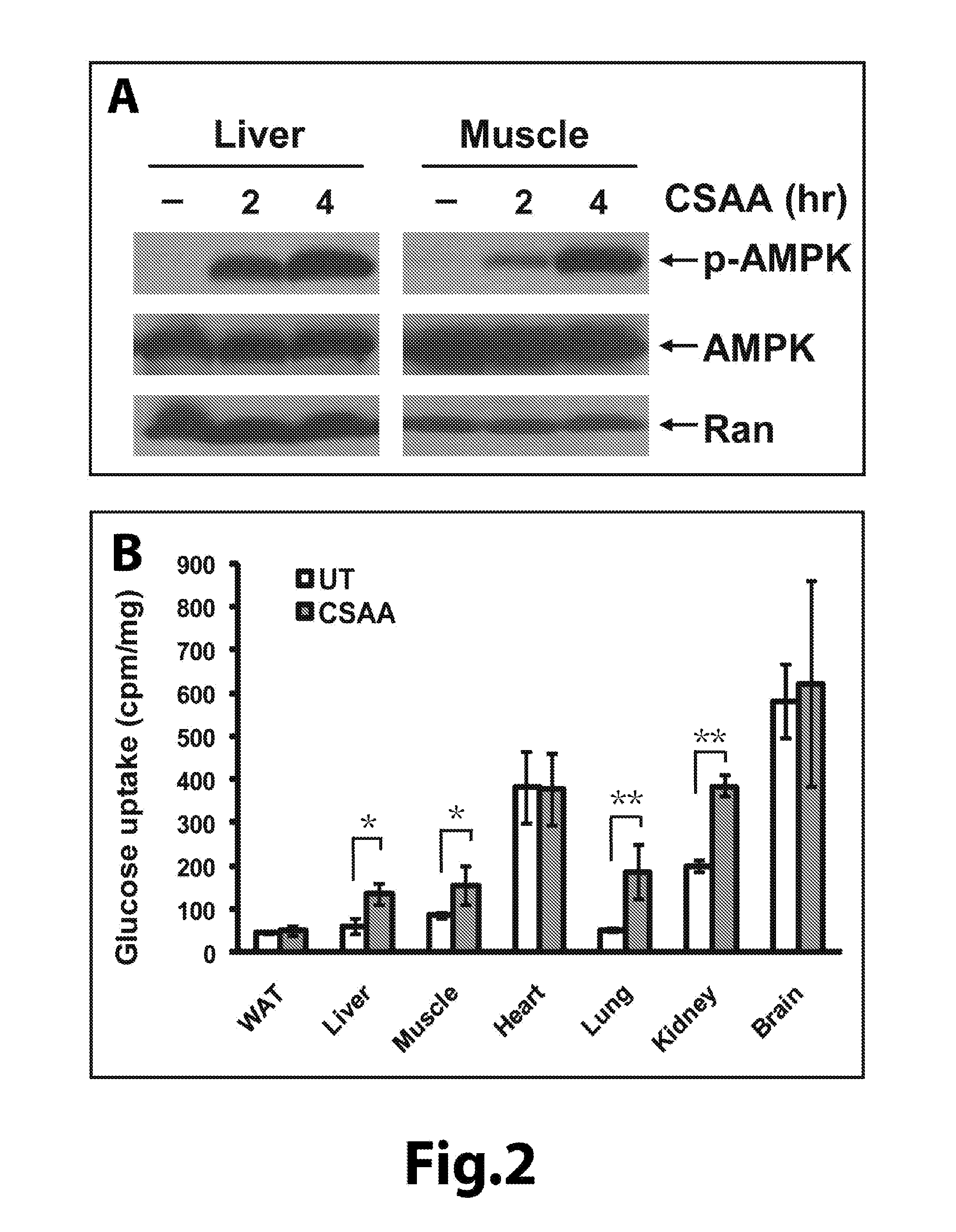Treatment of type ii diabetes and diabetes-associated diseases with safe chemical mitochondrial uncouplers
a technology of safe chemical and mitochondrial uncoupling, which is applied in the direction of biocide, drug composition, metabolic disorder, etc., can solve the problems of mitochondrial uncoupling and disruption of the energy cycle of mitochondria, and achieve the effects of effective reduction of plasma glucose levels, increased glucose uptake, and increased activity of ampk (5′ adenosine monophosphate-activated protein kinase)
- Summary
- Abstract
- Description
- Claims
- Application Information
AI Technical Summary
Benefits of technology
Problems solved by technology
Method used
Image
Examples
example 1
[0160]Acute treatment with 5-chloro-salicyl-(2-chloro-4-nitro) anilide 2-aminoethanol salt (CSAA) effectively reduces blood glucose in diabetic and pre-diabetic mice. The structure of CSAA is shown is FIG. 1A. To evaluate the effect of CSAA on blood glucose control, we injected the CSAA containing saline solution into either the diabetic db / db mice or the pre-diabetic C57 / B16 mice fed with high-fat diet for 10 weeks. As shown in FIG. 1, treatment with CSAA lowered blood glucose concentrations ˜1 hours after treatment and remained effective until about 4 hours. The dramatic decrease in blood glucose concentration was observed in both mouse strains. It was particular significant in the db / db mice, which showed a 30% reduction in blood glucose as compared to the control. These results indicate that CSAA has an acute effect in reducing blood glucose concentrations in diabetic and pre-diabetic mouse models.
example 2
[0161]The acute effect of CSAA in reducing blood glucose is associated with AMP-activated kinase (AMPK) activation and increased glucose uptake in tissues. Mitochondrial uncouplers may decrease the efficiency of ATP production, which may in turn induce a compensatory upregulation of glucose uptake. To test this idea, we measured the levels of phosphorylated AMPK, which reflect the activity of AMPK, in mouse liver after CSAA injection. AMPK was activated in response to increase of AMP (adenosine monophosphate) as a result of reduction of ATP. As shown in FIG. 2A, indeed, acute treatment with CSAA dramatically increased the levels of the phosphorylated AMPK. In addition, we directly measured the glucose uptake rates in various tissues of the mice acutely treated with CSAA. As shown in FIG. 2B, the glucose uptake rates significantly increased in liver, muscles, kidney, and lungs, but not in brain or white adipose tissue (WAT). Together, these results indicate that the acute effect of C...
example 3
[0162]Chronic oral treatment with CSAA reduces fasting blood glucose concentrations in db / db diabetic mice. We further determined if chronic oral treatment with CSAA has beneficial effect in lowing blood glucose concentrations in the db / db diabetic mice. As shown in FIG. 3A, starting at the age of 6 weeks, a two week oral treatment of CSAA (by feeding the mice with food containing CSAA), reduced the fasting blood glucose of the db / db mice to almost normal levels. The food intake rates between the two groups (mice fed with normal food or food containing CSAA) were not significantly different (FIG. 3B), which ruled out the possibility that CSAA may affect appetite and food uptake thereby causing the hypoglycemic effect. As time went by, the fasting blood glucose levels of the CSAA treated mice went up. But they remained significantly lower than those in the non-CSAA treated mice (data not shown). Importantly, the body weight and adiposity of the CSAA-treated db / db mice were not differ...
PUM
| Property | Measurement | Unit |
|---|---|---|
| Weight | aaaaa | aaaaa |
| Concentration | aaaaa | aaaaa |
| Therapeutic | aaaaa | aaaaa |
Abstract
Description
Claims
Application Information
 Login to View More
Login to View More - R&D
- Intellectual Property
- Life Sciences
- Materials
- Tech Scout
- Unparalleled Data Quality
- Higher Quality Content
- 60% Fewer Hallucinations
Browse by: Latest US Patents, China's latest patents, Technical Efficacy Thesaurus, Application Domain, Technology Topic, Popular Technical Reports.
© 2025 PatSnap. All rights reserved.Legal|Privacy policy|Modern Slavery Act Transparency Statement|Sitemap|About US| Contact US: help@patsnap.com



